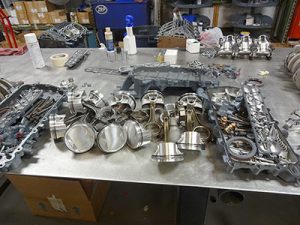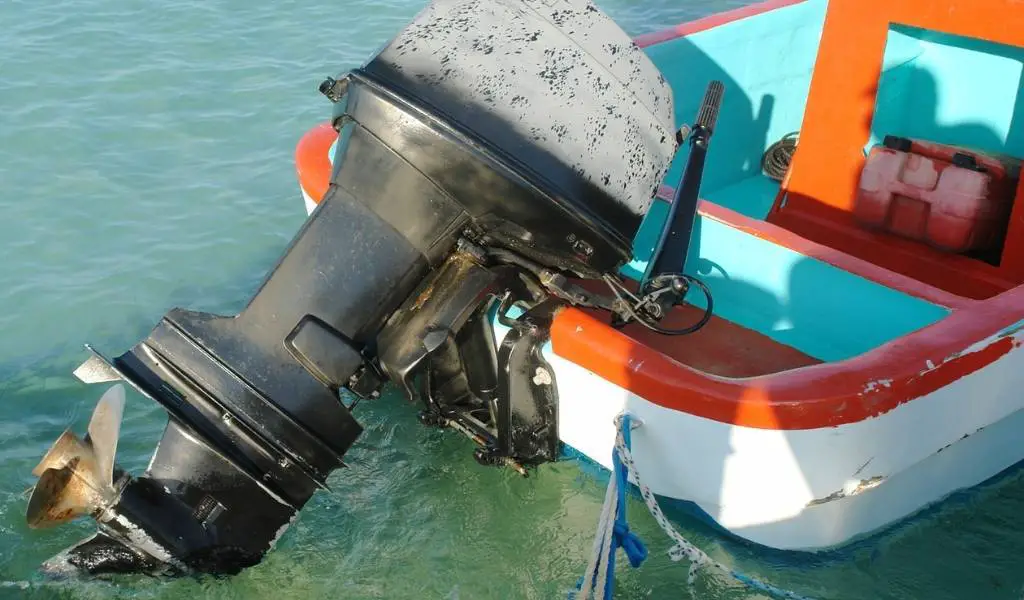Like your car, the lifespan of your outboard motor can seem to be a bit of a mystery. We’ve all spoken with other boat owners who tell us their engine lasted 5 years, 10 years, or 20 years. It often seems like too many factors go into the life and upkeep of any motor to pin down a specific timeline. Despite the apparent confusion, there are some general guidelines for knowing how long your outboard engine should last.
A typical two-stroke or four-stroke outboard engine should provide 1,500 hours of run time. Based on the average use of 200 hours per year, this will last 7-8 years. However, changing your oil every 50 hours of operation and regularly flushing the engine can see your outboard engine last 10 to 20 years.
Some of the problems that cause outboard motors to die prematurely include how it is used and how meticulous you are about oil changes and maintenance. These things directly affect how long you can expect your motor to last.
Want to know which outboard is best for saltwater use? Learn more.
How Many Hours Should a Motor Last?
For all of these reasons, it’s difficult to pin down how long an outboard motor will last. A typical estimate from the industry is that an outboards motor last around 1,500 hours of operation. Assuming the average owner uses their boat 200 hours a year, this would mean that the motor would last between seven and eight years. That sounds about right in my experience.
But there’s no reason that an outboard can’t last decades longer than that. There are plenty of 20 to 30-year-old two-stroke motors still in service all over the world. There’s no reason to think that today’s four-stroke engines won’t have similar longevities.
Similarly, outboards that are not taken care of or stored in the water may last much less time.
Other Factors to Consider
2-Strokes vs 4-Strokes
In terms of longevity, there’s really no difference between two-stroke and four-stroke engines, both have a similar life span of around 1,500 hours. Two-stroke engines are more vulnerable to wear and tear, however, they are also easier to maintain.
Two-stroke motors must have the proper fuel to oil mixture. This is controlled by the operator every time the boat is fueled up, with a few oil-injected engines being the exception. Improper mixing of the gas and oil is a significant cause of wear for two-stroke motors. If the engine requires a 100:1 mix, putting anything more or anything less in the tank will result in more wear and tear. Owners must know what mixture their engine requires and have a method of accurately mixing it at hand.
Saltwater
Running in saltwater is not the death knell for an outboard motor that some would have you believe. Any islander or coastal boat owner can tell you that outboard motors can last for decades, as long as they’re properly maintained.
What operating in seawater means is that you will have to spend a little more time caring for your outboard. You’ll have to watch more closely for corrosion issues. And you’ll have to flush it more often with clean freshwater.
Several great products on the market can help you clean your motor and keep it corrosion-free. Specifically, there are corrosion prevention sprays that you can coat the engine with that prevent corrosion from starting in the first place.
Common Causes of Premature Motor Death
How You Use Your Boat
One of the hardest things for any engine to survive is long periods of not being run. The longer that the oil sits in the pan not circulating, the longer there is for corrosion to set in. Bearings, piston rings, and all the other internal components of the motor require the oil to move around for lubrication and cleaning.
Unfortunately, outboard motors are notoriously underused. Many boats are used only a few hours a year. If you live in a climate that requires you to lay up for a season, your usage will be even lower.
The more often you can run your boat the longer its motor will last. The best situation for the boat and motor is to leave the dock at least once a week. Let the engine warm up, and then run it at cruising power for awhile.
The types of trips you make can also affect engine life. Starting and stopping cycles are rough on the engine, as is long periods of idling. Running at cruising RPM is what engines are made to do. The more time you spend making short trips at idle, the worse it is for your engine. Likewise, running your engine at maximum power all the time will stress the motor faster than running at a cruise setting.
Missed oil changes and regular maintenance are also a problem. Since most owners only use their engines a few hours here and there, it becomes easy to let maintenance slip by. It’s only been out two times, so why would it need an oil change now, right? While counting by the hour meter is convenient, most outboards will likely need to be changed based on calendar months rather than running hours.
Missed Maintenance

To figure out a schedule to keep your outboard running as long as possible, look to your outboard owner’s manual. You should find a table in the maintenance section outlining the tasks that should be completed, and the recommended interval published n both hours and months.
Always pick the lesser of the two. So, if you are supposed to change the oil every 50 hours or six months, and you’ve only done 10 hours in the last six months, then it’s time to change the oil.
Corrosion
Corrosion is the creeping cancer of your boat engine. There’s corrosion that you can see, and there’s corrosion on the inside that you can’t. You need to control both.
Frequent oil changes combat internal corrosion, as does running the engine often. Corrosion under the cowl requires you to clean and fix it when you notice it. Use a wire brush to clean bolts and trouble spots. The motor’s maintenance schedule should also have a lubrication guide that will help fight corrosion and keep all the pieces moving smoothly.
Since outboard motors are cooled by raw water, cleaning and flushing your engine with fresh water after each use will go a long way towards keeping it’s cooling channels corrosion-free. It’s easy to do as long as you have access to freshwater.
I use a specialty engine flush from CRC that removes salt and has a corrosion inhibitor to protect my engine while it’s sitting idle. Check Pricing on Amazon
It’s also worth noting that if you store your boat in the water, you should always lift your outboard as high as it will go. Metal objects left in saltwater are subject to galvanic corrosion between various underwater metals on your boat and in your marina. Outboard motors are best protected by keeping them lifted. Also, make sure your anodes are in good condition and replaced anytime they are more than half used.
Improper installation or Prop Selection
Like driving a stick shift car in the wrong gear all the time, having the wrong prop hung on your motor will cause big trouble in the long run.
Picking the right prop for a vessel involves some science and a little bit of trial and error. For this reason, when considering a new prop, it’s essential to consult an expert. Your local prop shop should be able to advise you on what sort of pitch and diameter combination will work right for your boat. When done correctly, your motor should be able to reach its maximum rated RPM at wide-open throttle.
Make certain the motor size matches your boat with this calculator.
Bad Fuel
Dirty fuel is probably the biggest leader in outboard motor problems. While most dirty fuels aren’t going to kill an outboard prematurely, they can cause many headaches and big maintenance bills for boat owners.
As previously mentioned, many boats sit idle for months at a time. During this time, the gasoline sits in the tank and deteriorates. If the gas has alcohol additives like ethanol, the alcohol attracts and bonds to water. This water can come from leaks in the system that let in rainwater, or it can come from condensation in the air on chilly days. Whatever the cause, outboard motors do not like running on water. Using additives can help a lot – read more.
The first step to preventing the problem is to avoid letting your gasoline sit for extended amounts of time. If it’s necessary, like when you’re winterizing your boat, consider a fuel additive to extend the gasoline’s life. And always avoid putting any ethanol fuels in your tank.
The second step to keeping a trouble-free engine is to prevent any fuel tank nasties from reaching your engine. All outboards should a high-quality fuel-water separator mounted where it can be easily inspected. This is your primary fuel filter. The best kinds have sight bowls under the filter so that you can see if any water has made its way into the system. You can occasionally drain the bowl to prevent excess water build-up. Carry spare filters on board just in case. And never rely on your outboard’s fuel filter to do the job alone.
I recommend the Sierra Fuel Separator, it filters particles as small as 10 microns. It has minimal pressure drop although this may depend on the size of your outboard and its pump.
What You Can Do To Make Your Motor Last Longer
Now that you know what issues cause premature motor death, it should be easier for you to prevent it from happening.
First, create a table or spreadsheet of maintenance items. Get out the owner’s or shop manual for your engine, and then write down all of the specific tasks that should be completed and how often you are supposed to do them. Record when they were last completed, and when they are next due to be done. If you are making a spreadsheet, you can program it so that it highlights cells that show overdue maintenance items.
Key things you can include on your maintenance record that will make your outboard engine last longer include:
- Change your oil every 50 hours of operation or six months
- Run your engine regularly, with proper flushing after each use
- Frequent oil and filter changes to combat internal corrosion
- Address corrosion under the cowl
- Change the gearcase lubricant according to your boat’s maintenance schedule
- Check the fuel filter element
- Regularly change the spark plugs
Besides maintenance, you can make sure your engine has clean fuel and a high-quality fuel filter. Make sure the filter is cleaned before each outing. And never put ethanol in the gas tank!
Conclusion
To keep your boat working great for years, just go boating! Running the engine and cruising the lake or bay regularly is probably the single best thing you can do to ensure that your motor will last as long as possible.
If you keep up on your regular maintenance, follow the manufacturer’s recommendations, and stay on top of any corrosion issues that pop up, your outboard motor should give you many years of trouble-free service.






